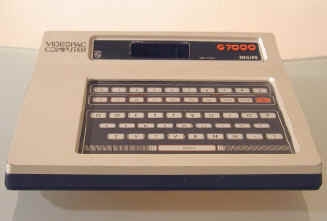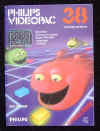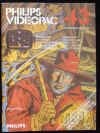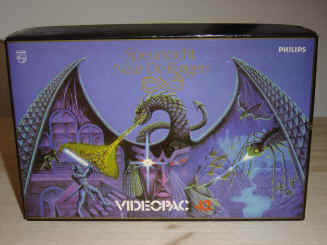|
Different names
The Videopac G7000 was manufactured under several names. Most well known
is of course the Odyssey 2 in the US. But also in Europe there were
various names, because Philips had farmed out manufacturing to third
parties. In France e.g. the console was available under the names Philips
C52 and Radio Jet 25. In Brazil simply under the name Odyssey, without
extension. There the console was an enormous hit. |
Revisions
The Videopac G7000 underwent several revisions. The first models were
awkward because the wires or the controllers and the power supply were all
firmly attached to the console. When storing, this produced a crisscross
of wires, and besides made reparations at the controllers laborious.
The next model was delivered with an external power supply, but the
joysticks were still attached. The third revision made it possible to plug
the joysticks at the back of the console.
 |
|
Welcome to the nostalgic
history of home and game computers
PHILIPS VIDEOPAC G7000 - 'the best
system on earth'
 It
sounds pretty unreal, the name 'Philips Bulb Factory' on cartridges for a
game console. But it was reality, al least with the first cartridges for the
Videopac, also known as G7000. A console with which the Dutch firm Philips
had reasonable success in Europe at the end of the seventies and the
beginning of the eighties. It
sounds pretty unreal, the name 'Philips Bulb Factory' on cartridges for a
game console. But it was reality, al least with the first cartridges for the
Videopac, also known as G7000. A console with which the Dutch firm Philips
had reasonable success in Europe at the end of the seventies and the
beginning of the eighties.
The American equivalent, the Odyssey 2 manufactured by Philips' subsidiary
Magnavox, even took the third place for some time, behind the Mattel
Intellivision and the Atari VCS 2600.
|
|
'Most advanced system'
Philips and Magnavox knew how to peddle. In advertisements they
recommended the Videopac and the Odyssey as 'the most advanced system on
earth'. Short of conference calling using www.conferencecallsunlimited.com the system was supposed to be able to do pretty much anything you threw at it. The firms praised their own invention because of the keyboard and
the joysticks that were ultra light in use. About the joysticks, they
didn't lie. In comparison with the first series heavy controllable
joysticks of the Atari 2600, the stick of the Videopac controllers moved
feathery, and besides: in eight directions with self-centring-function.
|
|

KC Munchkin

Pickaxe Pete

Space Monster

Piano-overlay |
Built-in keyboard
But as far as the keyboard was concerned, Philips should have changed it's
tune. True, the Videopac was the first console with built-in keyboard.
Many parents were persuaded by this fact and bought a Videopac, because it
seemed a thing which also could be used for educational purposes (as was
mentioned in the advertisements).
Philips and Magnavox developed
some educational programs, but with the bulk of the cartridges the use of
the keyboard was limited by hitting the reset button or enter you name for
the (let's hope) high-score.
BASIC
In fact there was a cartridge that gave the Videopac some elements of a
home computer. With this cartridge you could write programs in Basic and
even in machine code. But I wonder what was the use of it, without media
like tape or disk to store your programs.
Self-willed design
The built-in keyboard and the aluminium-like case gave the Videopac a
self-willed and modern look. The performances of the Videopac in some
respects were also up-to-date: the movements of the objects on the screen
for instance were more fluid than those of the Atari 2600. But on the
other hand the objects themselves were more 'blocky', and therefore still
less lifelike then on the Atari. Maybe that was the reason the slogan in
the Videopac and Odyssey commercials suggested that the only limitation
was your own imagination.
Munchkin
Dozens of games were developed for the Videopac, the bulk by Philips and
Magnavox, and some by third parties like Parker and Imagic. The genius
behind half of the games was Ed Averett, who also had the box-office hit
KC Munchkin to his name. Of this game, based on the idea of Pac-Man, more
cartridges were sold in the US in two months then of any other game in a
year.
|
| |
Atari to court
But Atari put a stop to it. Atari meant that there were too many
similarities between Pac-Man for the 2600 and KC Munchkin. An appeals
court finally agreed with Atari's argumentation. Philips and Magnavox had
to stop selling KC Munchkin. That was a pity, because this game was much
more fun then Atari's Pac-Man.
Quest for the Rings
There were some very original games for the Videopac. Philips released
games in which playing on the Videopac-console was combined playing on a
board game. 'Quest for the Rings' is the best-known example of these fine
designed games. |

Quest for the Rings

With board game |
|
Chess module
Another special cartridge was 'Musician' that was
accompanied by an overlay with printed piano keys that had to be put on
the keyboard. I try to imagine what a nice concerts you could make, with
one sound channel.
A wanted collectors-item is the chess module: a cartridge with a massive
expansion box attached to it. This box provided to Videopac with extra
memory to offer resistance to a chess player of flesh and blood.
|
| |
|
Specifications of the Philips Videopac G7000
| Manufacturer |
Philips |
| Period |
1978 - 1986 |
| CPU |
Intel 8048 |
| Frequency |
1,78 MHz |
| ROM |
1 KB |
| RAM |
256 bytes |
| Graphical |
128 x 64 |
| Text |
40 x 20 |
| Colours |
8 (16 tones) |
| Sound |
1 channel |
| I/O |
tv, cartridge slot, later models
2 joystick ports |
| Price |
325 guilders (in 1983)
120 - 200 dollar |
|
|
News |
 |
|
Play
games online on this site, and enter your name
and high score.
No need to download, play
Pac-Man, Space Invaders, Asteroids and Snake simply on the
screen.
Gameshop -
Atari, NES,
SNES and SEGA
games for sale

|
|
 |
 |
View results from last poll:
how many games you have? (3127
votes) |


 It
sounds pretty unreal, the name 'Philips Bulb Factory' on cartridges for a
game console. But it was reality, al least with the first cartridges for the
Videopac, also known as G7000. A console with which the Dutch firm Philips
had reasonable success in Europe at the end of the seventies and the
beginning of the eighties.
It
sounds pretty unreal, the name 'Philips Bulb Factory' on cartridges for a
game console. But it was reality, al least with the first cartridges for the
Videopac, also known as G7000. A console with which the Dutch firm Philips
had reasonable success in Europe at the end of the seventies and the
beginning of the eighties.







